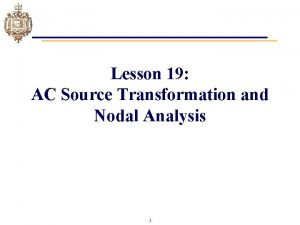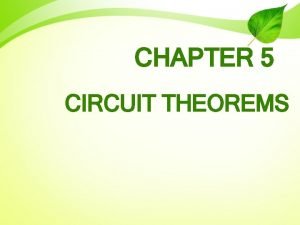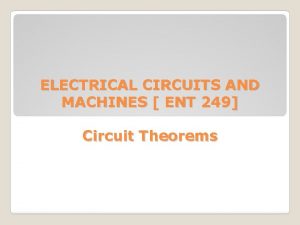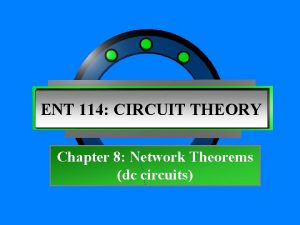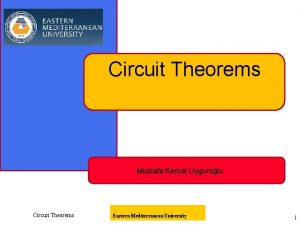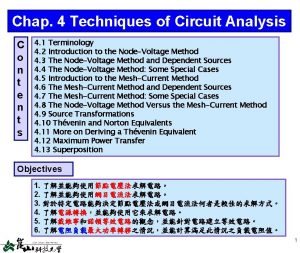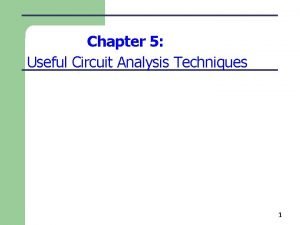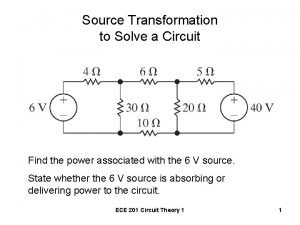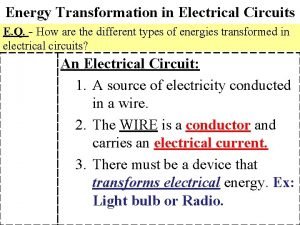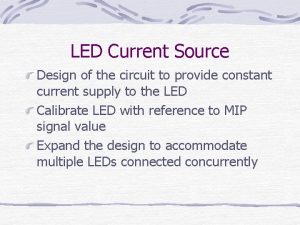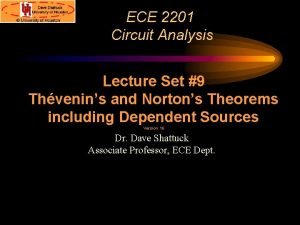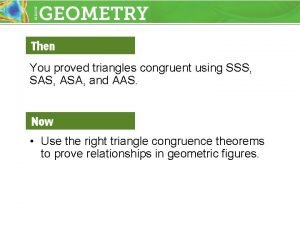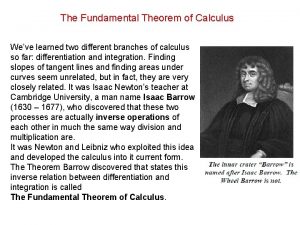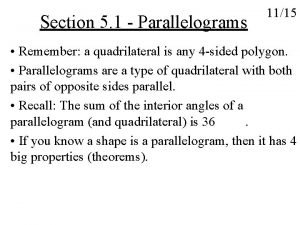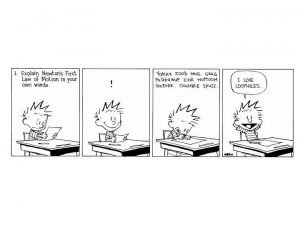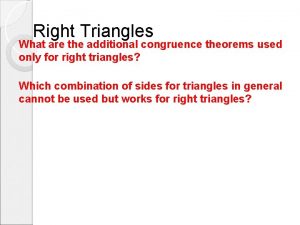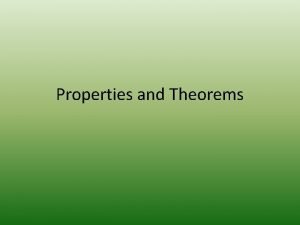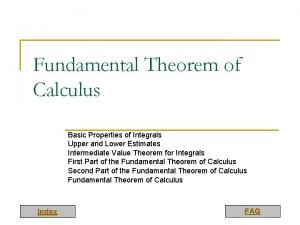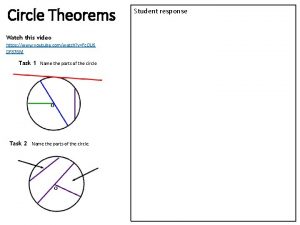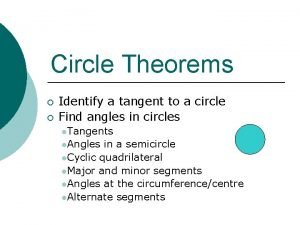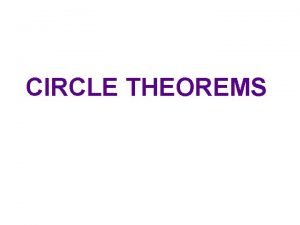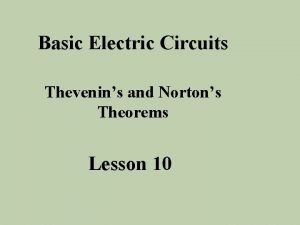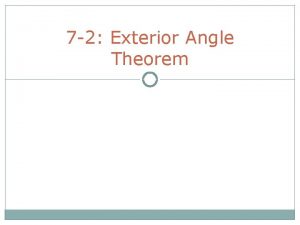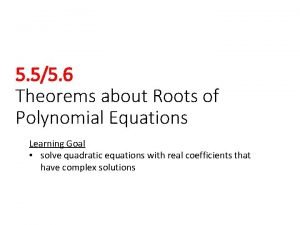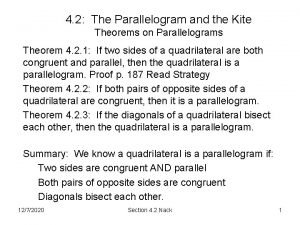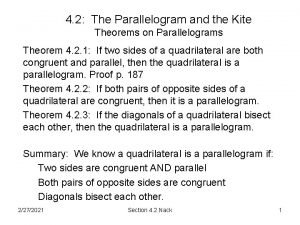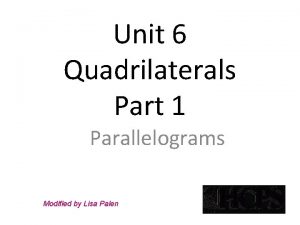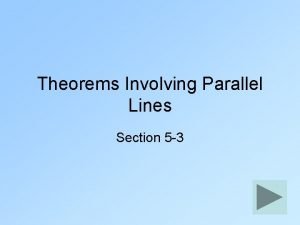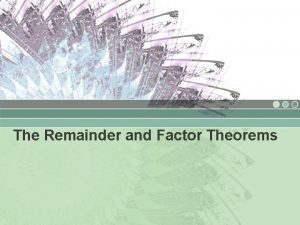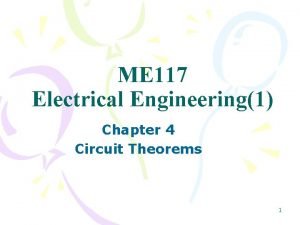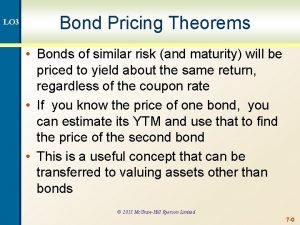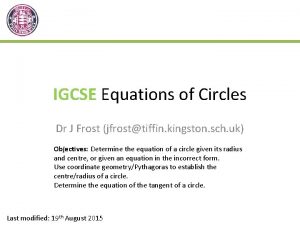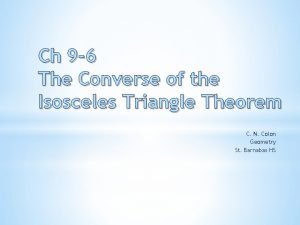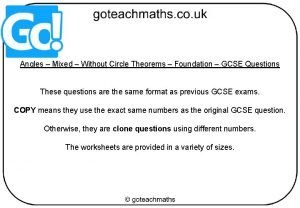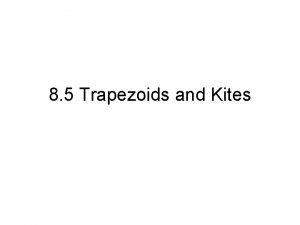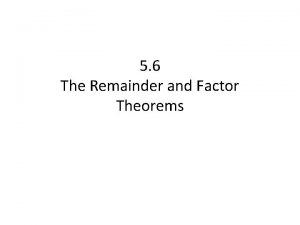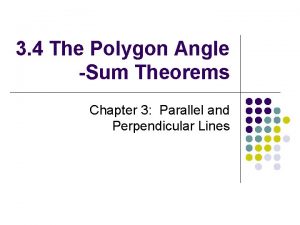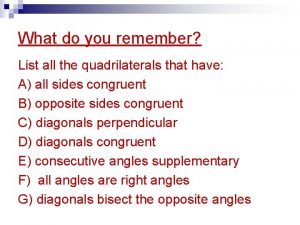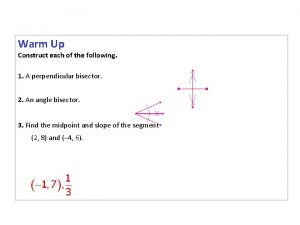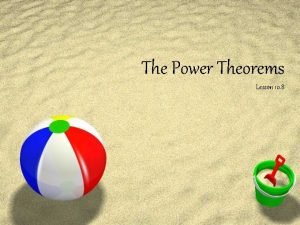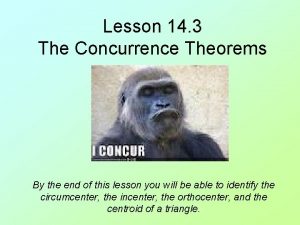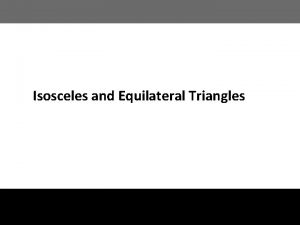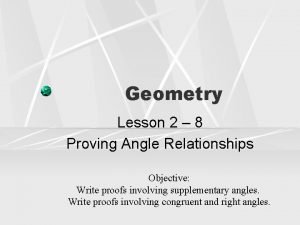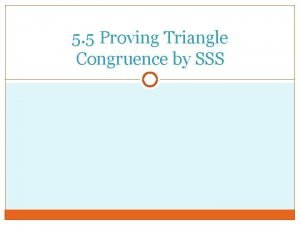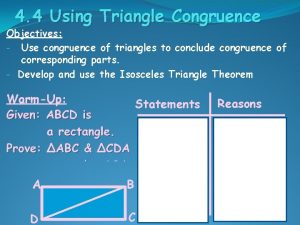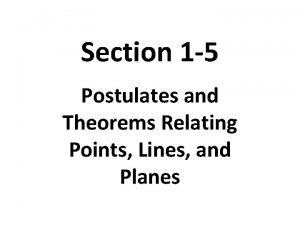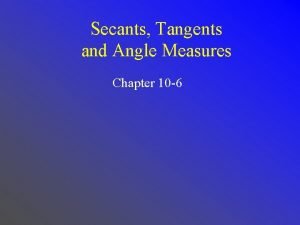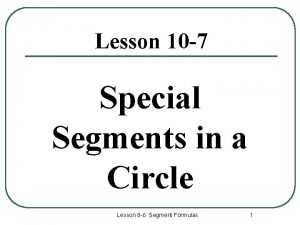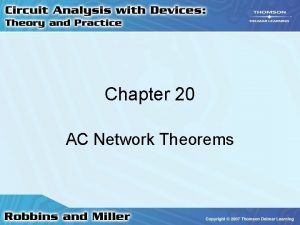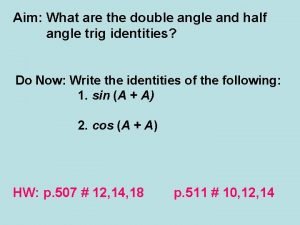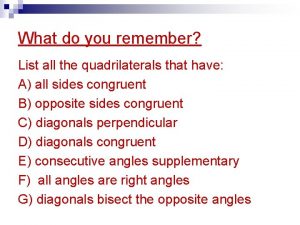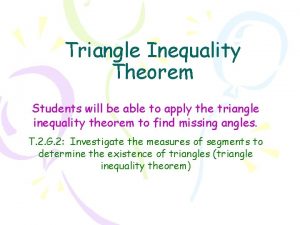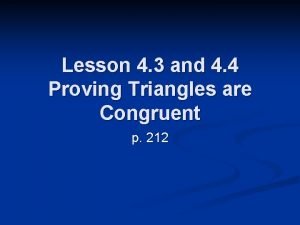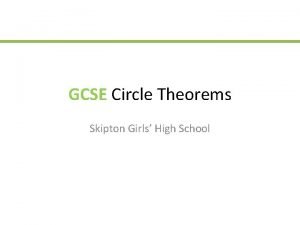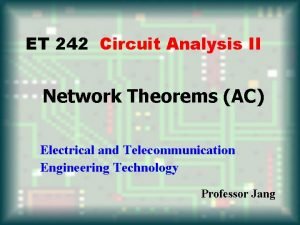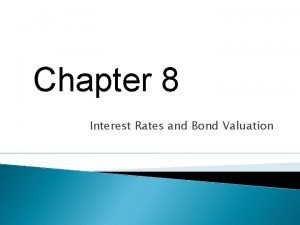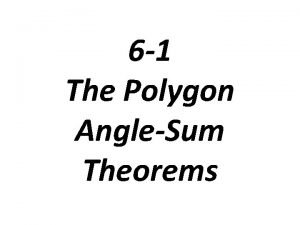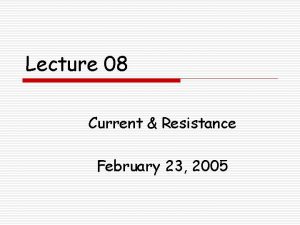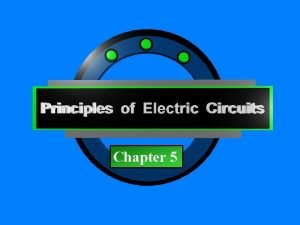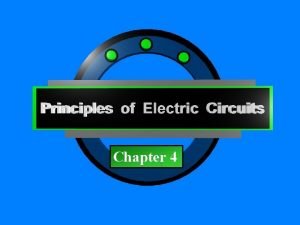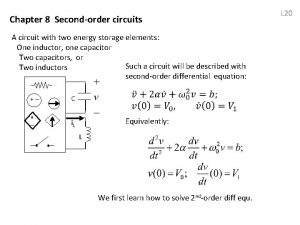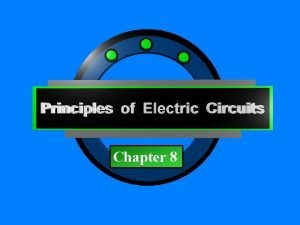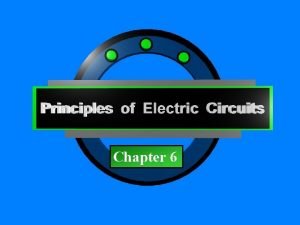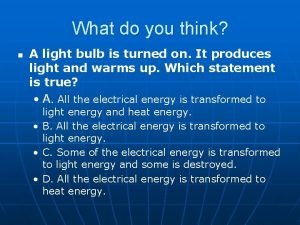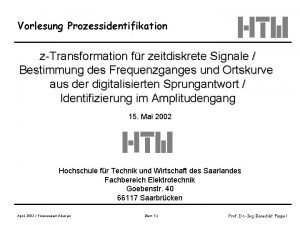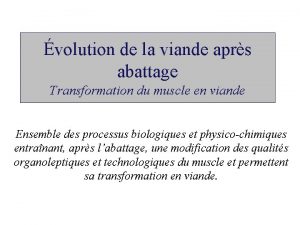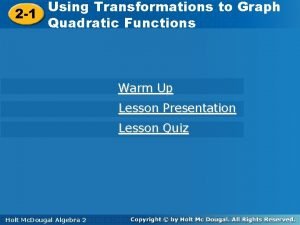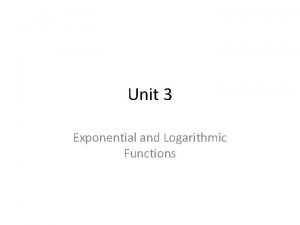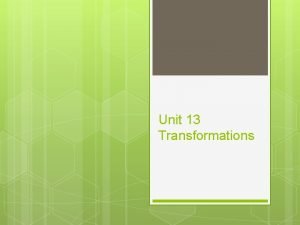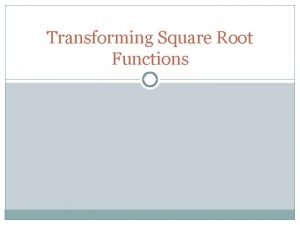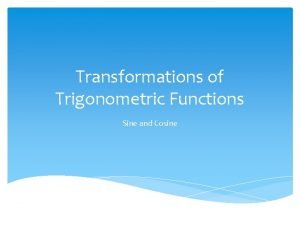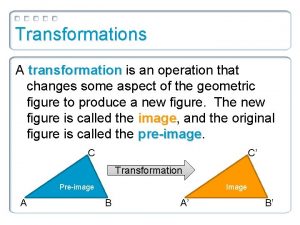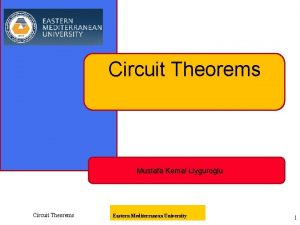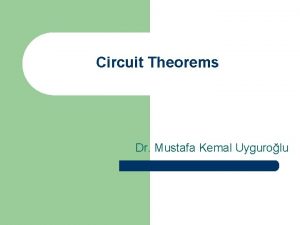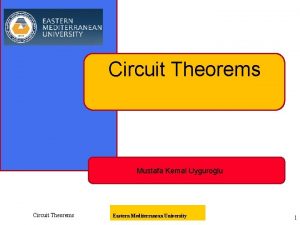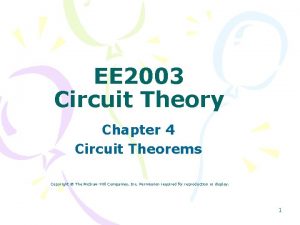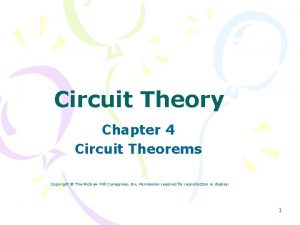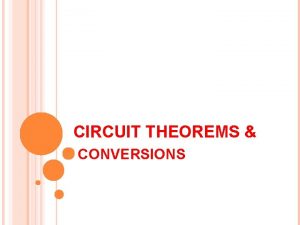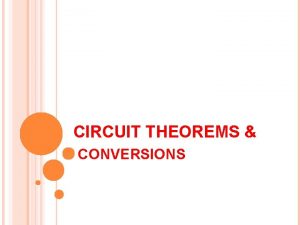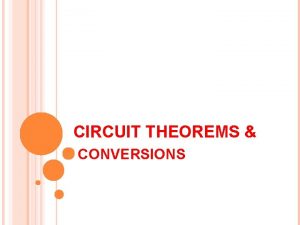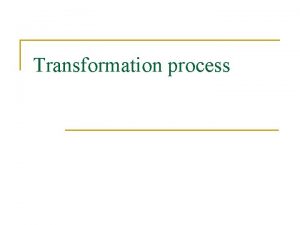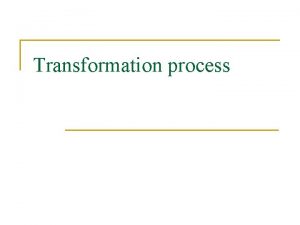CHAPTER 5 CIRCUIT THEOREMS CIRCUIT THEOREMS Source Transformation


















































































































- Slides: 114

CHAPTER 5 CIRCUIT THEOREMS

CIRCUIT THEOREMS • • • Source Transformation Thevenin’s Theorem Norton’s Theorem Maximum Power Transfer Superposition

SOURCE TRANSFORMATION Source Transformation is the process of replacing a voltage source vs series with a resistor R by a current source is in parallel with a resistor R, or vice versa Note: The arrow of the current source is directed toward the positive terminal of the voltage source

Example…

Source transformation procedure From To method Use,

From To method Use,

EXAMPLE Determine ix ix

ix

ix


EXAMPLE Use source transformation to reduce the circuit to a single voltage source in series with a single resistor

EXERCISE 1 Use source transformation to find i Ans: i=555. 5 m. A

EXERCISE 2 Use source transformation to determine the current and power absorbed by 8Ω resistor Ans: i=1 A P = 8 W

CIRCUIT THEOREMS • • • Source Transformation Thevenin’s Theorem Norton’s Theorem Maximum Power Transfer Superposition

THEVENIN EQUIVALENT CIRCUIT • Thevenin’s theoram states that a linear twoterminal circuit can be replaced by an equivalent circuit. • Thevenin equivalent circuit consist of an independent voltage source, VTh in series with a resistor RTh. Original circuit Thevenin equivalent circuit

Thevenin equivalent circuit:

• Thevenin voltage, VTh = open circuit voltage in the original circuit. • Thevenin resistance, RTh is the ratio of open-circuit voltage to the short-circuit current.

Step 1: Disconnect the load, RL Step 2: Find Thevenin’s Resistance, RTH Step 3: Find Thevenin’s Voltage, VTH Step 4: Determine the voltage across the load or current through it.

Detail Procedures: 1. Remove the load from the circuit. 2. Label the resulting two terminals. We will label them as a and b, although any notation may be used. 3. Set all sources in the circuit to zero. Voltage sources are set to zero by replacing them with short circuits (zero volts). Current sources are set to zero by replacing them with open circuits (zero amps).

4. Determine the Thévenin equivalent resistance, RTH, by calculating the resistance “seen” between terminals a and b. It may be necessary to redraw the circuit to simplify this step. 5. Replace the sources removed in Step 3, and determine the open-circuit voltage between the terminals. The resulting open-circuit voltage will be the value of the Thévenin voltage, VTH.

6. Draw the Thévenin equivalent circuit using the resistance determined in Step 4 and the voltage calculated in Step 5. As part of the resulting circuit, include that portion of the network removed in Step 1.

FINDING VTH Thevenin voltage, VTh = open circuit voltage in the original circuit.

FINDING RTH Case 1: If the network has no dependent sources, we turn off all independent sources. RTh is the input resistance of the network looking between terminals a and b.

FINDING RTH Case 2: If the network has dependent sources, we turn off all independent sources. Dependent sources are not to be turned off because they are controlled by circuit variables. We apply a voltage source vo at terminals a and b and determine the resulting current io. Then:

Or Alternatively, we may insert a current source io at terminals a-b as shown in Fig 2 and find the terminal voltage vo. Again: Either of the two approaches will give the same result. In either approach we may assume any value of vo and io. For example, we may use vo = 1 V or io = 1 A, or even use unspecified values of vo or io.


FINDING RTH Thevenin’s resistance can also be determined by placing a short circuit across the output terminals and finding the current through the short circuit.

Thevenin’s equivalent circuit

Example

STEP 1: To find VTH Using node-voltage method for open-circuit:

STEP 2: To find RTH Short-circuit condition at terminal a-b

Using Node-voltage method for short-circuit:

Short-circuit current: Thevenin resistance:

Thevenin equivalent circuit

EXAMPLE Using Thevenin theoram, find the equivalent circuit to the left of the terminals in the circuit in circuit below. Then find I

STEP 1: To find RTH Voltage source, 12 V Current source 2 A Short circuit Open circuit

STEP 2: To find VTH Supermesh equation At circuit Solve equation

VTH is equal to the voltage at 4Ω resistor Thevenin equivalent circuit

THEVENIN EQUIVALENT CIRCUITCircuit with dependent source 1. Find VTH 2. Find RTH METHOD 1: Step 1: turn off all independent sources. Step 2: Excite the circuit with either a 1 V voltage source or a 1 A current source Step 3: Find the current Io through 1 V voltage source/ voltage Vo across 1 A current source Step 4: METHOD 2: Step 1: Place a short circuit across the output terminals and find the current, ISC through the short circuit. Step 2:

EXAMPLE Obtain the Thevenin equivalent of the circuit

• Since there is no independent sources, value of VTH = 0 V • You will only have to find RTH • STEP 1: Excite the circuit with either a 1 V voltage source or a 1 A current source • STEP 2: Find Vo or Io • STEP 3:

• STEP 1: Excite the circuit with either a 1 V voltage source or a 1 A current source

• STEP 2: Find Vo or Io • Using mesh analysis, • From circuit, • and • Substitute in to equation at loop 1

• STEP 3:

EXAMPLE Find the Thevenin equivalent circuit

To find RTH: METHOD 1 KCL at node V 1: V 1 V 2

KCL at node V 2: Solve equation (1) and (2): V 1 V 2

To find RTH: METHOD 2 To find VTH: Using node-voltage method V + VTH - From the circuit:

To find ISC: Using node-voltage method V ISC


EXERCISE 1 Apply Thevenin theorem to find Vo Ans : RTH=5Ω VTH= 19. 2 V Vo=12. 8 V

EXERCISE 2 Obtain Thevenin equivalent Ans : RTH=0. 4762Ω VTH= 1. 9841 V

EXERCISE 3 Find Thevenin equivalent at terminal ab and solve for ix Ans : RTH=10Ω VTH= 0 V ix=0 A

CIRCUIT THEOREMS • • • Source Transformation Thevenin’s Theorem Norton’s Theorem Maximum Power Transfer Superposition

NORTON EQUIVALENT CIRCUIT • A Norton equivalent circuit consists of an independent current source, IN in parallel with the Norton equivalent resistance, RN. • Can be derive from a Thevenin equivalent circuit simply by making a source transformation. • Norton current, IN = the short-circuit current at the terminal of interest. • Norton resistance, RN = Thevenin resistance, RTh

Norton equivalent circuit Norton current, IN is the short circuit current flowing from terminal a and b

EXAMPLE Find the Norton equivalent circuit of the circuit shown below

To find RN Current source 2 A Voltage source 12 V Open circuit Short circuit

To find IN (a) For mesh 1 For mesh 2

Solve the equation

To find IN (b) For mesh 1 For mesh 2

Solve the equation VTH is equal to voltage at 5Ω

Norton equivalent circuit

EXAMPLE Find Norton equivalent circuit


Step 1: Source transformation

Step 2: Parallel sources and parallel resistors combined Series resistor combined

Step 3: Source transformation, series resistors combined, producing the Thevenin equivalent circuit THEVENIN EQUIVALENT CIRCUIT

Step 4: Source transformation, producing the Norton equivalent circuit NORTON EQUIVALENT CIRCUIT

EXERCISE 1 • Find the Norton equivalent with respect to terminal a-b Ans: RN=10Ω IN= 666. 67 m. A

EXERCISE 2 • Obtain Norton equivalent of the circuit below to the left of terminal a-b. Use the result to find current i Ans: RN=10Ω IN= -0. 4 A i= 2. 4 A

CIRCUIT THEOREMS • • • Source Transformation Thevenin’s Theorem Norton’s Theorem Maximum Power Transfer Superposition

MAXIMUM POWER TRANSFER • Two basic types of system: – Emphasizes the efficiency of the power transfer – Emphasizes the amount of power transferred.

• Maximum power transfer is a technique for calculating the maximum value of p that can be delivered to a load, RL. • Maximum power transfer occurs when RL=RTh. Maximum power theorem

Maximum power theorem Maximum power is transferred to the load when the load resistance equals the Thevenin resistance as seen form the load


CIRCUIT THEOREMS • • • Source Transformation Thevenin’s Theorem Norton’s Theorem Maximum Power Transfer Superposition

SUPERPOSITION PRINCIPLE • In a circuit with multiple independent sources, superposition allows us to activate one source at a time and sum the resulting voltages and currents to determine the voltages and currents that exist when all independent sources are activate. • The superposition principle states that the voltage across (or current through) an element in a linear circuit is the algebraic sum of the voltage across (or current through) that element due to each independent source acting alone

Step of Superposition principle 1. Deactivated all the sources and only remain one source at one time. Do circuit analysis to find voltages or currents. 2. Repeat step 1 for each independent sources. 3. Sum the resulting voltages or currents.

REMEMBER!!! 1. Independent voltage source will become short-circuit with 0Ω resistance. 2. Independent current source will become open-circuit. 3. Dependent sources are never deactivated when applying superposition.

Example… Find Vo

• Step 1: deactivated all sources except voltage source

• V 0 is calculated using voltage divider:

• Step 2: Deactivated all sources except current source

• V 0 is calculated by using current divider:

• Step 3: Sum all the resulting voltages: V 0 =2+5=7 V.

EXAMPLE Find io in the circuit below using superposition

STEP 1: Deactivate all independent source except 4 A current source and find I’o

STEP 2: Deactivate all independent source except 20 V voltage source and find i’’o

STEP 3: Sum all the resulting currents

EXERCISE 1 • Using superposition find V in the circuit below V=4. 1538 V

EXERCISE 2 Use superposition to find vo Vo=7 V

Question 3 (thevenin)

• Open-circuit voltage, Voc:

• Node-voltage equation for Voc

• Thevenin resistance, RTh:

• Thevenin equivalent circuit:

Question 4 (norton)

• Open-circuit current, Isc:

• Norton resistance, RN: RN = 4Ω

• Norton equivalent circuit:

Question 5 (superposition) • Use superposition principle to determine the voltage Vo.

• Deactivated current source

• Deactivated voltage source

• Summing the voltage V 0

PRACTICE 1 Find the Thevenin equivalent circuit of the circuit shown in figure below, to the left of the terminals a-b. Then find the current through RL = 6, 16, and 36Ω. Ans: RTH = 4Ω VTH = 30 V IL = 3, 1. 5, 0. 75 A.

PRACTICE 2 Find the Thevenin equivalent of the circuit in figure below. Ans: RTH = 6Ω VTH = 20 V

PRACTICE 3 Find the Norton equivalent circuit for the circuit in figure below. Ans: RN= 3Ω IN= 4. 5 A

PRACTICE 4 Using Norton’s theorem, find RN and IN of the circuit in figure below at terminals a -b. Ans: RN= 1. 67Ω IN= 6 A

PRACTICE 5 Find the Norton equivalent circuit of the circuit in figure below. Ans: RN= 1. Ω IN= 10 A

PRACTICE 6 Find the value of RL for maximum power transfer in the circuit of figure below. Find the maximum power. Ans: RL= 9Ω Pmax= 13. 44 W

PRACTICE 7 Determine the value of RL that will draw the maximum power from the rest of the circuit in figure below. Calculate the maximum power. Ans: RL= 4. 22Ω Pmax= 2. 901 W

PRACTICE 8 Using the superposition theorem, find vo in the circuit in figure below. Ans: Vo= 12 V

PRACTICE 9 Use superposition to find vx in the circuit in figure below. Ans: Vx= 12. 5 V
 Ac source transformation
Ac source transformation Use source transformation to find the value
Use source transformation to find the value Block diagram transformation theorems
Block diagram transformation theorems Circuit theorems
Circuit theorems Voltage devider rule
Voltage devider rule Dc circuit theorems
Dc circuit theorems Source transformation theorem
Source transformation theorem Mesh current
Mesh current Legacy source code transformation
Legacy source code transformation Rth
Rth Source transformation
Source transformation Source transformation examples
Source transformation examples Energy transformation in a simple circuit
Energy transformation in a simple circuit Led current source circuit
Led current source circuit Test source method circuit analysis
Test source method circuit analysis In series vs in parallel
In series vs in parallel Types of circuit
Types of circuit Parallel circuit circuit construction kit
Parallel circuit circuit construction kit Series vs parallel circuit
Series vs parallel circuit Complete and incomplete circuit diagram
Complete and incomplete circuit diagram Current split in parallel
Current split in parallel Venn diagram of climate and weather
Venn diagram of climate and weather The circulatory system
The circulatory system Advantages of parallel circuits over series circuit
Advantages of parallel circuits over series circuit Chapter 9 agricultural transformation and rural development
Chapter 9 agricultural transformation and rural development Chapter 9 agricultural transformation and rural development
Chapter 9 agricultural transformation and rural development Chapter 23 the transformation of europe
Chapter 23 the transformation of europe Congruence theorems
Congruence theorems Trigonometry maze answer
Trigonometry maze answer The fundamental theorem of calculus
The fundamental theorem of calculus Angle-angle similarity
Angle-angle similarity A quadrilateral
A quadrilateral Cyclic coordinate definition
Cyclic coordinate definition Cyclic coordinates and conservation theorems
Cyclic coordinates and conservation theorems Right hypotenuse leg
Right hypotenuse leg Relationships of lines
Relationships of lines Theorem list
Theorem list Polygon interior angles theorem
Polygon interior angles theorem Grade 11 circle geometry theorems
Grade 11 circle geometry theorems Isosceles triangle theorems
Isosceles triangle theorems Calculus proof
Calculus proof Circle theorems geogebra
Circle theorems geogebra Centre theorem
Centre theorem Tangent rules circle
Tangent rules circle Circle theorems gcse questions
Circle theorems gcse questions Angle in the same segment of a circle are equal
Angle in the same segment of a circle are equal Thevenin theorem examples
Thevenin theorem examples The exterior angle theorem answer key
The exterior angle theorem answer key 5-5 theorems about roots of polynomial equations
5-5 theorems about roots of polynomial equations Theorems on kite
Theorems on kite Kite theorems
Kite theorems Rhombus proofs
Rhombus proofs 5-3 theorems involving parallel lines
5-3 theorems involving parallel lines Remainder factor theorem
Remainder factor theorem Greene's theorem
Greene's theorem Electrical theorems
Electrical theorems Bond pricing theorems
Bond pricing theorems Equation of a circle dr frost
Equation of a circle dr frost Conclusion on theorems of circle
Conclusion on theorems of circle Converse of isosceles triangle theorem examples
Converse of isosceles triangle theorem examples Gcse
Gcse Trapezoid theorems
Trapezoid theorems 5-6 the remainder and factor theorems
5-6 the remainder and factor theorems Polygon angle sum theorem
Polygon angle sum theorem A midsegment of a trapezoid quizizz
A midsegment of a trapezoid quizizz Congruence theorems
Congruence theorems The remainder theorem
The remainder theorem Power theorems
Power theorems Circumcenter
Circumcenter Corollary to the isosceles triangle theorem
Corollary to the isosceles triangle theorem Theorem 2-8
Theorem 2-8 4 triangle congruence theorems
4 triangle congruence theorems 5 triangle congruence theorems
5 triangle congruence theorems Using triangle congruence theorems
Using triangle congruence theorems Postulate 1-5
Postulate 1-5 10-6 secants tangents and angles
10-6 secants tangents and angles Segment lengths intersecting chords secants and tangents
Segment lengths intersecting chords secants and tangents Ac network theorems
Ac network theorems Double angle theorems
Double angle theorems Iscoceles trapezoid
Iscoceles trapezoid Inequality theorem
Inequality theorem Reflexive property
Reflexive property Theorems
Theorems How to remember circle theorems
How to remember circle theorems Ac network theorems
Ac network theorems Pure discount bond
Pure discount bond Angle sum theorem
Angle sum theorem Chapter 23 electric current circuit happenings
Chapter 23 electric current circuit happenings Fundamentals of electric circuits chapter 9 solutions
Fundamentals of electric circuits chapter 9 solutions A series circuit cannot have
A series circuit cannot have The circuit chapter 4 summary
The circuit chapter 4 summary Inductance energy
Inductance energy The circuit chapter 8
The circuit chapter 8 Principles of electric circuits 10th edition answer key
Principles of electric circuits 10th edition answer key The circuit chapter 6 summary
The circuit chapter 6 summary The circuit chapter 3 summary
The circuit chapter 3 summary What is the energy transformation in a light bulb
What is the energy transformation in a light bulb Z transformation korrespondenztabelle
Z transformation korrespondenztabelle Pantelance
Pantelance Quadratic transformations quiz
Quadratic transformations quiz Virtual labs energy transformation
Virtual labs energy transformation Example of exponential equation
Example of exponential equation A transformation with a line of symmetry
A transformation with a line of symmetry Came et tige poussoir
Came et tige poussoir Quiz transmission de mouvement
Quiz transmission de mouvement Vertical answer
Vertical answer The setting of transforming moments
The setting of transforming moments Transforming linear functions lesson 6-4
Transforming linear functions lesson 6-4 Energy transformation sentence
Energy transformation sentence Transformations of sine and cosine functions
Transformations of sine and cosine functions Energy transformation of wall clock
Energy transformation of wall clock Describe fully the single transformation
Describe fully the single transformation Shear transformation in computer graphics
Shear transformation in computer graphics What type of transformation is this?
What type of transformation is this? Mgf method transformation
Mgf method transformation
